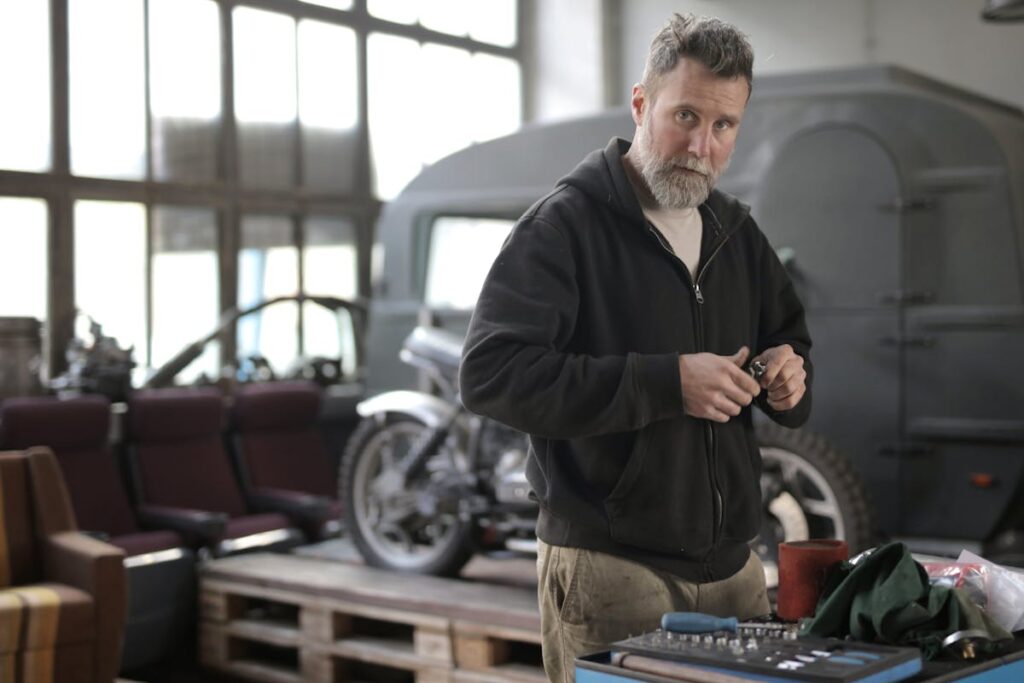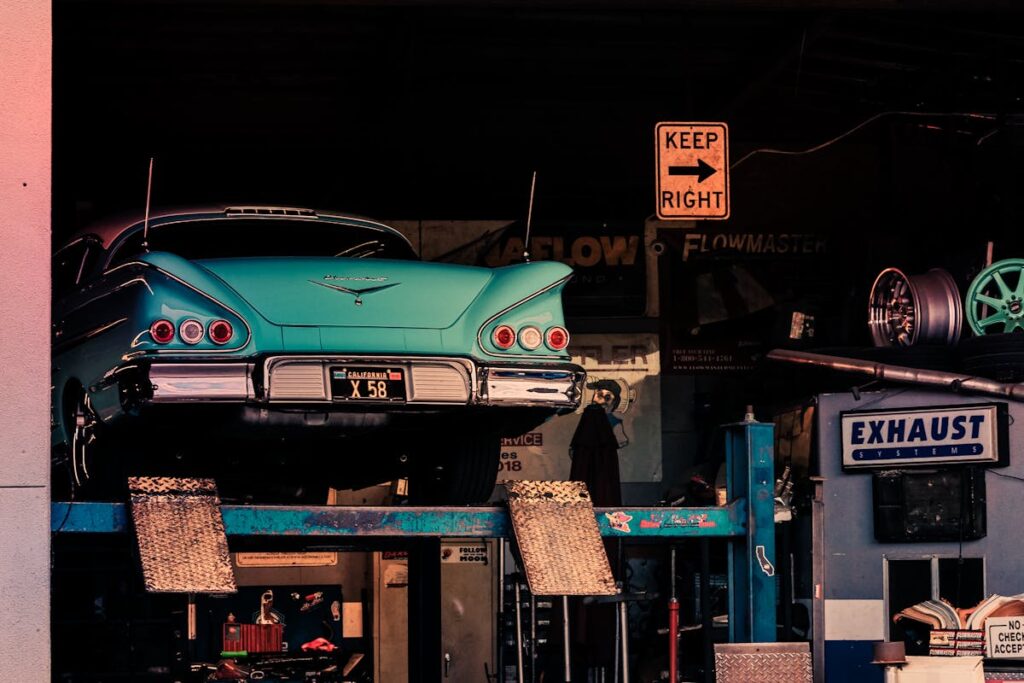The pursuit of original parts for classic cars, a task both challenging and rewarding, plays an essential role in maintaining the vehicle’s authenticity and value. This process, requiring a firm understanding of the car’s specifications, efficient use of VIN decoding, and adept navigation of specialized catalogs and online resources, can often feel like a treasure hunt. By fostering connections within classic car communities, exploring swap meets, and skillfully operating within auction spaces, one can secure these elusive components. However, the journey doesn’t end there – ensuring the quality and authenticity of these parts is equally important. What methods have you found most successful in this intricate process?
Key Takeaways
- Understanding the classic car’s VIN and specifications helps identify the correct original parts.
- Online markets, auction sites, auto shows, and local salvage yards are key sources for classic car parts.
- Auto parts catalogs, specialized books, and classic car forums provide valuable information for part identification.
- Authenticity of parts can be verified through detailed photos, receipts, third-party services, and seller reputation.
- Engaging with classic car communities can foster knowledge exchange and facilitate the sourcing of original parts.
Understanding the Importance of Original Parts
Undeniably, original parts play a crucial role in the preservation and restoration of classic cars. They are the lifeblood of any restoration project, underpinning not only the vehicle’s performance but also its value and authenticity. The significance of original parts cannot be overstated.
When it comes to restoration quality, using original parts can make a significant difference. Original parts guarantee that the classic car remains true to its era, maintaining its historical accuracy. They also offer unparalleled fit and function, as they were specifically designed and manufactured for that particular model. This means that they work seamlessly with the car’s systems, guaranteeing peak performance and reducing the risk of future mechanical issues. For more insights on maintaining the authenticity of your restoration, consider exploring effective preservation techniques for vintage cars.
Moreover, original parts are a crucial factor in preserving the car’s value. Classic car enthusiasts and collectors often place a premium on vehicles restored with original parts, recognizing their contribution to the car’s integrity and authenticity. Consequently, a restoration project using original parts is not only a labor of love but also an investment, preserving the car’s heritage while potentially enhancing its worth.
Identifying Parts: The Basics
The process of identifying original parts for classic cars involves a fundamental understanding of Vehicle Identification Numbers (VINs), careful research of classic car parts, and proficient navigation of auto parts catalogs. The VIN, imprinted on each car, can provide crucial information about the original parts used in specific models. By combining this knowledge with thorough research and catalog navigation, one can accurately identify and locate essential components for any classic car restoration project.
Understanding Vehicle Identification Numbers
Comprehending Vehicle Identification Numbers (VINs) is fundamental for those seeking original parts for classic cars. VINs provide a wealth of information about a vehicle’s origin, its historical significance, and even the specific parts used in its construction.
VIN decoding is a process that transforms this seemingly random string of characters into a detailed vehicle biography, revealing aspects such as the manufacturer, model year, assembly plant, and more. A vehicle’s VIN can be found in various locations, including the dashboard, engine block, and frame. It is essential to note that each section of the VIN has a specific meaning, and decoding it accurately is imperative for sourcing the correct parts.
Historically, VINs were not standardized until 1981, meaning classic cars manufactured before this date might have unique or unusual VIN configurations. These older VINs often contain fewer characters and less information than modern ones, but they still hold significant value in identifying original parts for classic cars. Understanding and accurately decoding a classic car’s VIN is a key step in ensuring the authenticity and integrity of its restoration.
In the next section, we will investigate deeper into researching classic car parts.
Researching Classic Car Parts
A considerable part of restoring a classic car involves identifying and sourcing the correct parts. As a first step, you must familiarize yourself with the basics of the car’s make, model, and year, as components can vary greatly. A thorough understanding of your vehicle’s original specifications is essential for guaranteeing part compatibility.
Different restoration techniques require different parts; some methods may necessitate original components, while others might allow for modern substitutes. Knowledge of these techniques and their requirements can guide your search for the appropriate parts.
Once you have a solid understanding of your vehicle’s needs, begin your research. Specialized automotive books, enthusiast forums, and online databases can provide invaluable information about the original parts of your car. Remember to cross-reference your findings to verify accuracy.
When researching, consider the condition of the parts. While some parts can be restored, others may need to be replaced entirely. It’s also important to note where the parts were manufactured, as this can affect their compatibility and quality.
Navigating Auto Parts Catalogs
Finding your way through auto parts catalogs can initially seem like a challenging task, given the sheer volume of components listed. However, understanding catalog organization and part compatibility can make this process considerably less intimidating.
Firstly, catalogs are typically organized by car make, model, and year. This is an essential aspect to grasp as it provides direction when sourcing specific parts. Sometimes, they are further divided into sections based on car systems, such as engine, transmission, or suspension. By understanding this organization, you can quickly locate the section you need.
Secondly, part compatibility is another key element to take into account. It involves understanding which parts work with your specific classic car model. This is vital as some parts may look similar but vary subtly in design or functionality across different models or years. Catalogs often include information about part compatibility, but it’s also worthwhile to consult online resources or speak to experts to confirm.
Where to Find Classic Car Parts
Steering through the world of classic car restoration, an essential aspect to contemplate is knowing where to source authentic parts. Local salvage yards often house a vast array of components and are a great place to start your search. These venues stock parts from a multitude of models and years, offering a treasure trove for those engaged in vintage restoration.
Specialized suppliers are another valuable resource. They cater specifically to the classic car market and often stock hard-to-find parts. Regional events, such as auto shows and swap meets, also provide opportunities to find original parts. Here, private collectors and professional restorers gather, offering a diverse range of components for sale.
Classic forums and niche marketplaces serve as platforms where enthusiasts share knowledge, trade parts, and offer advice on sourcing components. Estate sales, though less predictable, can sometimes yield surprising finds, especially if the previous owner was a collector.

Online Resources for Car Parts
The digital age has revolutionized the search for classic car parts, presenting numerous online resources that offer a variety of options. Exploring virtual automotive markets and traversing auction sites can provide access to a plethora of components worldwide. However, it is equally essential to scrutinize these online resources for authenticity, to guarantee the originality and quality of the parts procured.
Exploring Virtual Automotive Markets
Maneuvering the vast landscape of online markets is an essential skill for any classic car enthusiast in search of original parts. Virtual marketplaces have transformed the way we source these components, with a myriad of digital exchanges offering a treasure trove of hard-to-find items.
From online auctions to automotive forums, there are a multitude of platforms where one can engage in virtual networking, often leading to unexpected yet fruitful finds. Sourcing strategies must consequently take into account not only the parts required, but also the best online venues to search for those parts.
Online classifieds are another rich source of original parts, with many classic car communities posting items for sale or trade. These communities are not only about transactional exchanges, however. They are also places where enthusiasts can share knowledge, compare notes on restoration projects, and offer advice on best sourcing practices.
Ultimately, exploring virtual automotive markets is about more than just finding parts. It’s about immersing oneself in a global community of classic car enthusiasts, and leveraging the collective wisdom of this community to restore these magnificent machines to their former glory.
Navigating Auction Sites
Diving into the world of online auction sites can be an essential step in the quest for original classic car parts. These platforms offer a treasure trove of rare and hard-to-find components that can be significant in restoring your beloved classic to its former glory. However, a nuanced understanding of bidding strategies and auction etiquette is fundamental to successfully navigate this online marketplace.
Optimal bidding strategies often involve patient waiting and keen observation. By understanding the behavior of other bidders, you can ascertain the right moment to place your bid. Early bidding may inflate prices, while last-minute bids could lead to a bidding frenzy. It is important to strike a balance, leveraging timing and bid amount to secure the desired part.
Auction etiquette, though often overlooked, is significant in maintaining a positive reputation within the auction community. Respectful and fair bidding, timely payment, and clear communication with sellers foster trust and could open doors to exclusive parts listings.
Authenticity Verification Online
In the domain of classic car restoration, verifying the authenticity of parts procured online is a critical step. Online authentication is an essential process that guarantees the originality of the auto parts and validates the reliability of the seller. This process is increasingly paramount with the proliferation of digital marketplaces offering classic car parts.
There are various methods of online authentication that one can deploy to verify the genuineness of parts. Detailed photographs, documentation such as receipts, certifications, or historical records, and the seller’s reputation are among the most effective ways to ascertain authenticity. Further, there are specialized forums and online communities where experts and enthusiasts share knowledge and advice about specific parts and vendors.
In some cases, third-party authentication services can be utilized. These services provide an extra layer of security and peace of mind, especially when dealing with high-value parts. They have established procedures for verifying the authenticity of parts, often involving direct examination, historical research, and comparison to known authentic samples.
Navigating Car Swap Meets
Maneuvering car swap meets can seem a bit intimidating, but with the right strategy, it can be a goldmine for finding original parts for classic cars. The key is to approach these events armed with effective swap strategies and a knack for negotiating prices.
Firstly, research is vital. Before you even set foot at a swap meet, familiarize yourself with the market prices for the parts you need. This will give you a solid foundation for negotiating prices and guarantee you’re not overpaying.
Secondly, develop an eye for quality. Original parts for classic cars can vary greatly in condition, and it’s important to discern whether a part is worth its asking price. Look for signs of excessive wear, corrosion, or damage that could affect performance.
Lastly, don’t be afraid to haggle. Swap meets are, by nature, a place of negotiation. Start by offering a price slightly lower than what you’re willing to pay, and don’t be afraid to walk away if the seller isn’t willing to negotiate.
Navigating car swap meets demands patience and persistence, but with proper preparation and a strategic approach, you can unearth valuable parts for your classic car restoration project.
Building Relations With Classic Car Communities
While it may seem challenging at first, building relations with classic car communities is an invaluable strategy for sourcing original parts. A high level of community engagement often leads to opportunities for knowledge exchange and resource sharing, both of which can aid in the acquisition of hard-to-find parts.
Local meetups and vintage car shows present perfect collaboration opportunities for enthusiasts. Networking events organized by these communities serve to broaden one’s contacts, opening up avenues to source parts through member benefits or direct referrals.
Engaging in restoration projects can also offer enthusiast mentorship. Experienced members often have a wealth of knowledge about sourcing parts and can offer guidance to newcomers. This mentorship can be the key to successfully sourcing original parts for your classic car.
In essence, immersing oneself in the classic car community not only assists in finding original parts but also provides an enriching experience filled with knowledge exchange and collaboration. Remember, these communities are built on a shared passion for classic cars – leverage this to your advantage and you’ll find that sourcing original parts becomes a less arduous task.
Tips for Purchasing Quality Parts
Maneuvering the marketplace for classic car parts can be a meticulous task, but with the right knowledge, it can be a rewarding experience. The first step is identifying what you need. Understand your car’s specifics, such as the model, year, and manufacturer. This will assist in narrowing down the search for the appropriate parts.
The part quality plays a significant role in the longevity and performance of your classic car. Always prioritize quality over price; cheap parts may not last long and could cause further damage. Inspect the parts thoroughly before purchasing. Look for any signs of wear, cracks, or rust. If you are sourcing from online, verify the seller provides clear photos and detailed descriptions.
The importance of sourcing strategies cannot be overstated. Establish a network of trusted suppliers. Car shows, classic car communities, and professional restorers can provide valuable leads. Online auctions, specialty stores, and even junkyards can be treasure troves for rare parts.
Frequently Asked Questions
How Do I Determine the Authenticity of a Vintage Car Part?
To determine the authenticity of a vintage car part, utilize part identification methods such as serial numbers, logos, and manufacturer details. Additionally, an expert appraisal can provide a thorough verification of the part’s authenticity.
Can I Use Modern Parts as Replacements in Classic Cars?
While modern replacements can be used in classic cars, it’s crucial to evaluate compatibility concerns. These replacements should not compromise the vehicle’s integrity, functionality, or historical authenticity where preservation is the key objective.
What Should I Know About Restoring a Classic Cars Interior Upholstery?
Restoring a classic car’s interior upholstery involves careful selection of upholstery materials to maintain authenticity. Mastery of restoration techniques, including stitching and fitting, is essential to preserve the car’s original aesthetic and increase its value.
How Can I Preserve the Longevity of Original Classic Car Parts?
To preserve the longevity of original classic car parts, regular part maintenance is essential. Utilize preservation techniques such as careful cleaning, lubrication, and protective coatings to prevent wear and tear, ensuring the parts’ endurance over time.
Are There Specific Insurance Considerations for Classic Cars With Original Parts?
Yes, insurance considerations for classic cars with original parts are paramount. Thorough coverage is recommended, considering classic valuation. It’s crucial to choose a policy that specifically values these unique, hard-to-replace components appropriately.

